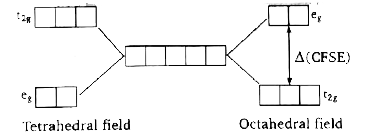Ti3+ is purple, while Ti4+ is colourless, because
there is no crystal field effect in Ti4+
The energy difference between eg and t2g orbitals of Ti4+ is quite high and hence, does not fall within the visible region
Ti4+ had 3d0 configuration
Ti4+ is a very small cation when combated to Ti3+ and hence, does not absorb any radiation.
The correct Answer is:C
Topper's Solved these Questions
Similar Questions
When degenerate d-orbitals of an isolated atom/ion come under influence of magnetic field of ligands, the degeneray is lost. The two set t2g(dxy,dyz,dxz)andeg(dx2−dx2−y2 are either stabilized or destabilized depending upon the nature of magnetic field. it can be expressed diagrammatically as:

Value of CFSE depends upon nature of ligand and a spectrochemical series has been made experimentally, for tetrahedral complexes, Δ is about 4/9 times to Δ0 (CFSE for octahedral complex). this energy lies in visible region and i.e., why electronic transition are responsible for colour. such transition are not possible with d0andd10 configuration.
Q. Ti3+(aq). is purple while Ti4+(aq). is colourless because:
View SolutionWhen degenerate d-orbitals of an isolated atom/ion come under influence of magnetic field of ligands, the degeneray is lost. The two set t2g(dxy,dyz,dxz)andeg(dx2−dx2−y2 are either stabilized or destabilized depending upon the nature of magnetic field. it can be expressed diagrammatically as:

Value of CFSE depends upon nature of ligand and a spectrochemical series has been made experimentally, for tetrahedral complexes, Δ is about 4/9 times to Δ0 (CFSE for octahedral complex). this energy lies in visible region and i.e., why electronic transition are responsible for colour. such transition are not possible with d0andd10 configuration.
Q. Ti3+(aq). is purple while Ti4+(aq). is colourless because:
View Solution
Knowledge Check
Ti2+ is purple while Ti4+ is colourless because
Athere is no crystal field effect in Ti4+BTi2+ has 3d2 configurationCTi4+ has 3d2 configurationDTi4+ is a very small cation when compared to Ti2+ and does not absorb any radiation.Ti2+ is purple while Ti4+ is colourless because
Athere is no crystal field effect in Ti+4BTi2+ has 3d2 configurationCTi4+ has 3d2 configurationDTi4+ is a very small cation when compard to Ti2+ and hence. Does not absorb any radiation.When degenerate d-orbitals of an isolated atom/ion come under influence of magnetic field of ligands, the degeneray is lost. The two set t2g(dxy,dyz,dxz)andeg(dx2−dx2−y2 are either stabilized or destabilized depending upon the nature of magnetic field. it can be expressed diagrammatically as:

Value of CFSE depends upon nature of ligand and a spectrochemical series has been made experimentally, for tetrahedral complexes, Δ is about 4/9 times to Δ0 (CFSE for octahedral complex). this energy lies in visible region and i.e., why electronic transition are responsible for colour. such transition are not possible with d0andd10 configuration.
Q. Ti3+(aq). is purple while Ti4+(aq). is colourless because:Athere is not crystal field effec in Ti4+BThe energy difference between t2gandegTi4+ is quite high and does not fall in the visible regionCTi4+ has d0 configurationDTi4+ is very small in comparison to Ti3+ and hence does not absorb any radiation
When degenerate d-orbitals of an isolated atom/ion come under influence of magnetic field of ligands, the degeneray is lost. The two set t2g(dxy,dyz,dxz)andeg(dx2−dx2−y2 are either stabilized or destabilized depending upon the nature of magnetic field. it can be expressed diagrammatically as:

Value of CFSE depends upon nature of ligand and a spectrochemical series has been made experimentally, for tetrahedral complexes, Δ is about 4/9 times to Δ0 (CFSE for octahedral complex). this energy lies in visible region and i.e., why electronic transition are responsible for colour. such transition are not possible with d0andd10 configuration.
Q. Ti3+(aq). is purple while Ti4+(aq). is colourless because:
View SolutionCuSO4 is colourless while CuSO45H2O is coloured. Why?
[Ti(H2O)6]3+ is coloured while [Sc(H2O)6]3+ is colourless, why?
View Solution[Ti(H2O)6]3+ is coloured while [Sc(H2O)6]3+ is colourless . Explain.
View SolutionStatement-1: [Ti(H2O)6]3+ is violet in colour while Ti3+ is colourless.
Statement-2: Light correspondign to dnergy of blue-green region is absorbed by the complex to excite the electron from t2g level to eg level.
View SolutionStatement-1: [Ti(H2O)6]3+ is violet in colour while Ti3+ is colourless.
Statement-2: Light correspondign to dnergy of blue-green region is absorbed by the complex to excite the electron from t2g level to eg level.
View Solution
